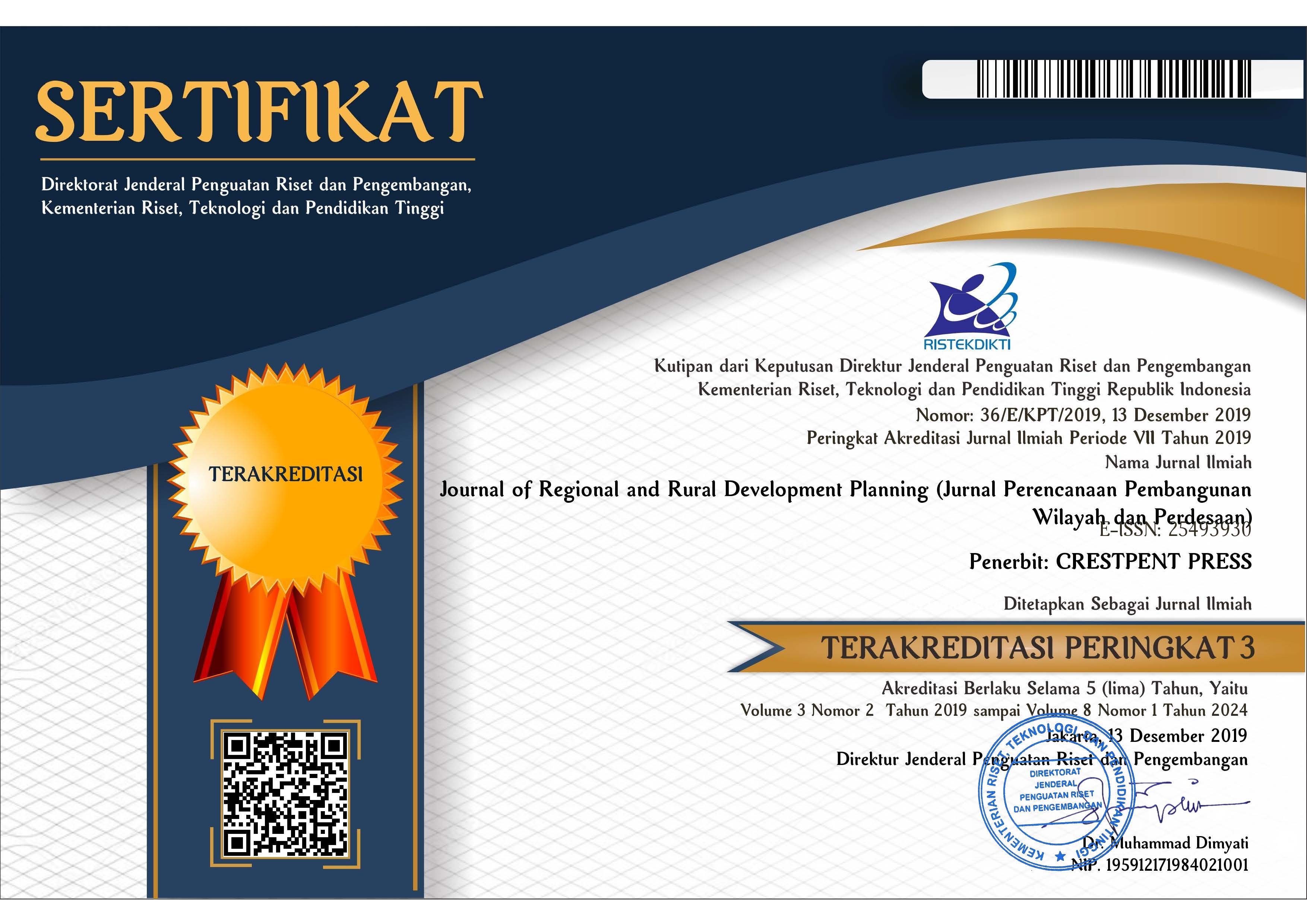Transformasi Perdesaan: Kajian Fisik, Sosial Ekonomi, dan Laju Transformasi di Wilayah Peri Urban Surakarta
Abstract
The development of peri urban areas arise as a transition zone from rural into urban nature resulting the changes in characteristics of its area or commonly referred to as rural transformation. The rural transformation case has complexities indicated by the changes in terms of landscape and the shifts in terms of economic structure which previously was caused by the transformation from rural into urban. This research aims to analyze the characteristics which is resulted from the process in rural transformation at the border of Surakarta City, precisely in Colomadu District, and to analyze how fast the transformation is. The data in this research consist of physical aspects which are in the form of image and socio-economic characteristics. The quantitative descriptive analysis and spatial analysis are conducted in this research using remote sensing and map overlays. This research results that the transformation occurred between 2000 up to 2020 in Colomadu District showed significant development in urban characteristics. It is indicated by the shrinkage on agricultural land by 37% and the changes in the socio-economic activities of its society. Besides, there is also an uneven spreading on the rates of transformation in which the high transformation rates are found to be more dominant in those which directly adjacent to Surakarta City.
References
Budiyantini, Y., & Pratiwi, V. (2016). Peri-urban Typology of Bandung Metropolitan Area. Procedia - Social and Behavioral Sciences, 227(November 2015), 833–837. https://doi.org/10.1016/j.sbspro.2016.06.152
Cohen. (2006). Urbanization in developing countries: Current trends, future projections, and key challenges for sustainability.
Fahmi, F. Z., & Sari, I. D. (2020). Rural transformation, digitalisation and subjective wellbeing: A case study from Indonesia. Habitat International, 98(April 2019), 102150. https://doi.org/10.1016/j.habitatint.2020.102150
Ginting, S. W. (2010). Transformasi spasial dan diversifikasi ekonomi pada wilayah peri-urban di Indonesia. Jurnal Arsitektur Dan Perkotaan “KORIDOR, 1(1), 60–64.
Kim, M. (2012). Peri-urbanization and its impacts on rural livelihoods in Mumbai ’ s urban fringe. Peri-Urbanization and Its Impacts on Rural Livelihoods in Mumbai’s Urban Fringe 48th ISOCARP Congress, 1–10.
Kurnianingsih, N. A., & Rudiarto, I. (2014). Analisis Transformasi Wilayah Peri-Urban pada Aspek Fisik dan Sosial Ekonomi (Kecamatan Kartasura). Jurnal Pembangunan Wilayah & Kota, 10(3), 265. https://doi.org/10.14710/pwk.v10i3.7784
Legates, R., & Hudalah, D. (2014). Peri-urban planning for developing east asia: Learning from chengdu, china and yogyakarta/kartamantul, indonesia. Journal of Urban Affairs, 36(S1), 334–353. https://doi.org/10.1111/juaf.12106
Long, H. (2011). Analysis of rural transformation development in China since the turn of the new millennium. Applied Geography. https://doi.org/https://doi.org/10.1016/j.apgeog.2011.02.006
Puspa Sari, D. P., Asyifa, I., Derman, I. F., Jayanti, D. R., & Hanatya, F. Y. (2018). A Rural Transformation Model: The facts of rural development in the Surakarta Metropolitan Region. IOP Conference Series: Earth and Environmental Science, 158(1). https://doi.org/10.1088/1755-1315/158/1/012056
Rudiarto, I., Handayani, W., & Pigawati, B. (2013). Zona Peri-Urban Semarang Metropolitan : Perkembangan. Tata Loka, 15(2), 116–128.
Sugiyono. (2008). Metode penelitian pendidikan:(pendekatan kuantitatif, kualitatif dan R & D). Alfabeta.
Surya, B. (2016). The Processes Analysis of Urbanization, Spatial Articulation, Social Change and Social Capital Difference in the Dynamics of New Town Development in the Fringe Area of Makassar City (Case Study: In Metro Tanjung Bunga Area, Makassar City). Procedia - Social and Behavioral Sciences, 227(November 2015), 216–231. https://doi.org/10.1016/j.sbspro.2016.06.065
Webster, D. R. (2002). On the Edge: Shaping the Future of Peri-urban East Asia. In Stanford University/Asia Pacific Research Center (Issue May). Stanford University Press.
Winarso, H., Hudalah, D., & Firman, T. (2015). Peri-urban transformation in the Jakarta metropolitan area. Habitat International, 49, 221–229. https://doi.org/10.1016/j.habitatint.2015.05.024
Yunus, H. S. (2008). Dinamika Wilayah Peri Urban : Determinan Masa Depan Kota. Pustaka Pelajar.
Copyright (c) 2023 Journal of Regional and Rural Development Planning (Jurnal Perencanaan Pembangunan Wilayah dan Perdesaan)

This work is licensed under a Creative Commons Attribution-ShareAlike 4.0 International License.




.png)














